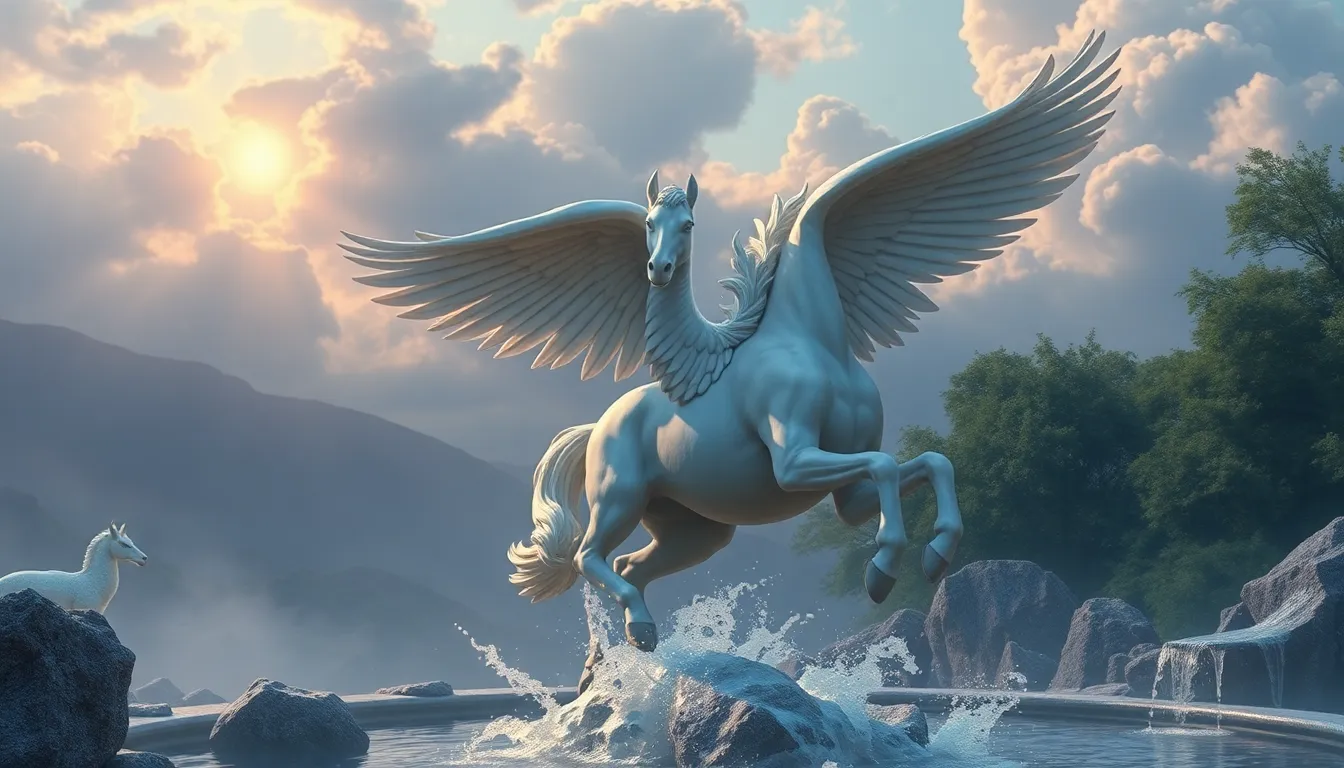Pegasus and the Fountain of Inspiration: Myths Behind the Muse
I. Introduction
Pegasus, the magnificent winged horse, occupies a prominent place in Greek mythology. Born from the blood of Medusa when she was slain by Perseus, Pegasus symbolizes not only beauty and grace but also the power of inspiration. Throughout history, the concept of the muse has played a crucial role in art and literature, serving as a guiding force for creativity.
This article aims to explore the connection between Pegasus and the notion of inspiration, delving into the myths surrounding this legendary creature and its association with the muses of Greek mythology.
II. The Myth of Pegasus
The origins of Pegasus are rooted deeply in Greek mythology. According to ancient texts, Pegasus emerged from the sea foam when Perseus beheaded Medusa. This divine horse was known for its ability to fly and was often depicted as a symbol of poetic inspiration.
Among Pegasus’ key adventures, one notable story is his service to the hero Bellerophon. Together, they faced the fearsome Chimera, a fire-breathing monster. With the aid of Pegasus, Bellerophon was able to defeat the beast, showcasing the bond between heroism and inspiration provided by this majestic creature.
- Symbolism of Pegasus: Pegasus represents the transcendence of earthly concerns, soaring into the realm of the divine and the creative.
- Connection to Art: As a creature that embodies inspiration, Pegasus serves as a reminder of the heights one can reach through creativity.
III. The Muses: Guardians of Inspiration
In Greek mythology, the Muses are the nine goddesses who preside over the arts and sciences, inspiring creativity in all forms. Each Muse is associated with a specific domain:
- Calliope: Muse of epic poetry
- Clio: Muse of history
- Erato: Muse of love poetry
- Euterpe: Muse of music
- Melpomene: Muse of tragedy
- Polyhymnia: Muse of sacred poetry
- Terpsichore: Muse of dance
- Thalia: Muse of comedy
- Urania: Muse of astronomy
The relationship between Pegasus and the Muses is significant. As Pegasus flew into the heavens, he is often depicted as carrying inspiration to the Muses, reinforcing their role as the divine sources of creativity.
IV. The Fountain of Inspiration: A Symbolic Exploration
One of the most notable symbols of inspiration in Greek mythology is the Fountain of Hippocrene, which was said to have been created by Pegasus when he struck a rock with his hoof on Mount Helicon. This fountain is not just a physical manifestation but also a metaphorical source of artistic inspiration.
The mythological significance of the Fountain of Hippocrene lies in its association with creativity and the arts. It was believed that drinking from this fountain would bestow the gift of poetic inspiration upon the artist. The connection between Pegasus and this fountain further cements his role as a source of divine creativity.
V. Artistic Representations of Pegasus and the Muses
Pegasus has been a popular subject in both classical and contemporary art. Artists throughout history have used his image to convey themes of beauty, freedom, and creativity. Notable representations include:
- Ancient Pottery: Many ancient Greek vases depict Pegasus in flight, often alongside the Muses.
- Renaissance Paintings: Artists like Raphael and Botticelli incorporated Pegasus into their works, symbolizing inspiration.
- Modern Art: Contemporary artists continue to draw on the imagery of Pegasus, exploring themes of creativity and transcendence.
The Muses have also inspired countless artists and writers throughout history. Their influence can be seen in various literary works, from the epics of Homer to the poetry of the Romantic era. Significant works inspired by Pegasus and the Muses include:
- The Iliad and The Odyssey: Homer invokes the Muses to guide his storytelling.
- Ode to a Nightingale: John Keats reflects on inspiration and its fleeting nature.
- The Birth of Venus: Botticelli’s painting captures the essence of beauty, echoing the influence of the Muses.
VI. Modern Interpretations of Pegasus and the Muse
In contemporary culture, Pegasus remains a relevant symbol of inspiration. The image of the winged horse is often used in literature, film, and art to represent the pursuit of creativity and the quest for knowledge. The concept of the muse has also evolved, now encompassing a broader range of interpretations, including:
- Personal Muse: Many artists view their muses as individuals who inspire their work.
- Abstract Muses: The idea of finding inspiration in nature, experiences, or emotions.
Examples of modern artists drawing inspiration from these myths include musicians, writers, and visual artists who cite Pegasus and the Muses as central figures in their creative processes. The enduring power of these myths continues to ignite the imagination and inspire new generations of creators.
VII. The Psychological Perspective on Inspiration
The connection between mythology and creativity has been explored in psychology, highlighting how stories like those of Pegasus and the Muses influence the creative process. Myths serve as archetypal symbols, representing universal themes that resonate with the human experience.
Studies suggest that engaging with these archetypes can enhance creativity by:
- Stimulating Imagination: Myths encourage individuals to think beyond the ordinary.
- Providing Frameworks: They offer narratives that can shape the artistic vision.
- Connecting Emotionally: Myths evoke feelings that can be channeled into creative expression.
VIII. Conclusion
In conclusion, the significance of Pegasus and the Muses in inspiring creativity is profound. These mythological figures embody the essence of artistic inspiration and serve as reminders of the heights that creativity can reach. Their enduring presence in art and literature reflects the timeless nature of these myths and their relevance in contemporary culture.
As we explore our own sources of inspiration, let us remember the legacy of Pegasus and the Muses, encouraging us to soar to new heights in our creative endeavors.




